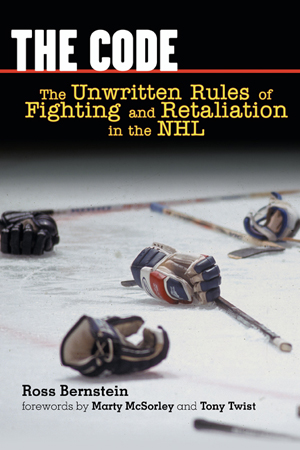 During the NHL lockout in 2006, you’d be hard pressed to find a hockey scribe that wasn’t writing an editorial piece about the current state of the league. Ranging from over-inflated player salaries to the bevy of rule changes the league was pushing for to make the game more exciting, most of them had only a select few things on which to gorge their keyboards.
During the NHL lockout in 2006, you’d be hard pressed to find a hockey scribe that wasn’t writing an editorial piece about the current state of the league. Ranging from over-inflated player salaries to the bevy of rule changes the league was pushing for to make the game more exciting, most of them had only a select few things on which to gorge their keyboards.
Minnesota author and life-long hockey fan Ross Bernstein however, decided to do something much different. Always fascinated with the game, he decided to research and learn as much as he could about one facet of the game that has intrigued millions of fans since the league’s inception in 1917: fighting. Interviewing a host of legendary hockey tough guys such as Tony Twist and Marty McSorley, Bernstein wrote “The Code: The Unwritten Rules of Fighting and Retaliation in the NHL†and finally revealed the world of hockey fighting to the fans who wanted to know why these behemoths drop the gloves.
The unspoken rules that every hockey player abides by, or “The Code,†as Bernstein calls it, is a system devised to protect talented players and makes sure that every player is responsible for their actions on the ice. While the majority of the athletes on the ice follow “The Code,†there are exceptions, which of course lead to, you guessed it, fisticuffs.
“It’s all about respect,†Bernstein said. “You have to always be accountable for your actions. When you decide to play like a jerk and hit people from behind or take liberties with someone and be disrespectful, you have to be held accountable. In hockey, there are serious consequences for actions like that. In that regard, hockey is very unique in the fact that it is allowed to police itself.â€
The players doing the policing, known as enforcers, make sure that “The Code†isn’t broken. These are the players that have inspired the creation of websites like HockeyFights.com and Hockeyfighters.com in recent years. Among their teammates, they are often the most respected players on their team and are almost always the most popular. New hockey fans may not think enforcers play much of a role in the success of the teams they play on, but Bernstein thinks quite different.
“Fighters, in my opinion, are like kickers and punters in the NFL,†said Bernstein, who also wrote the best-selling “Remembering Herbie: Celebrating the Life and Times of Hockey Legend Herb Brooks†in 2003. “They’re specialists and without them, you can’t win. Just like the kickers, they don’t get the same amount of respect, because they usually can’t skate as well as the other players. Nevertheless, they’re very important pieces to a championship team and it’s still a very important part of the game.â€
Having these enforcers patrol the ice every night, ready to protect their team at a moments notice, Bernstein believes the game is safer than it would be otherwise.
“Many people don’t understand that in hockey, there are a series of checks and balances,†he said. “If you’re a player that likes to take shortcuts on the ice and play dirty, your teammates won’t even want you around after a while. The way the code works is if someone isn’t held accountable for their actions and doesn’t ‘show up’ afterwards, his teammates won’t want him on the bench. Believe it or not, as barbaric as it may seem, fighting cleans up the game. Where I live, the Minnesota Wild have Derek Boogaard as our enforcer. He’s six foot seven and 270 pounds. He’s an animal. Without his presence on the bench, you wouldn’t see Marian Gaborik, Brian Rolston or Pavol Demitra scoring goals. If the opposition knows they can take liberties with those guys, they can’t win and have someone like Boogaard on your team gives them confidence and lets them get in front of the net and skate without fear of getting whacked.â€
However, many of the leagues top tough guys, players like Chris Simon and McSorley in particular have had problems keeping up with some of more talented players, leading to an unusual amount of suspensions by the very people who were expected to police the game.
“It’s been a crazy year,†said Bernstein. “There have been so many different things going on. What I think is happening is because of the new rule changes, a-la getting rid of the redline, the cutting down on obstructions and the salary cap, the way of the enforcer is slowly, but surely going the way of the dinosaur. I don’t know if a Tony Twist would make it in today’s game. Even Tie Domi also retired very quietly. Guys like that are always the most popular players amongst their teammates, but they’re kind of a luxury that you can’t afford to keep.â€
With the role of the enforcer changing, Bernstein doesn’t think fighting will stop all together, he just feels a new type of player will emerge and take its place.
“I think the agitators are the new wave,†Bernstein said. “In New York, you have a guy like Sean Avery. He’s a perfect example; he can play, he can hit, he’ll fight, he’ll turtle and he’ll draw penalties. He’s the new hybrid. He’s not a big lumbering snuffaluffagus. He’s not going to take up space and come on the ice like a nuclear bomb when his buttons are pushed and beat the crap out of somebody. I think guys today have to take a regular shift and contribute, kill penalties and even be able to take a penalty shot at the end of a game if they had to.â€
Even though Bernstein is a fan of the rough stuff, he still feels that the game will have plenty of passion and emotion if the enforcers do become a thing of the past. However, even if the exit of the traditional scrapper is an inevitable one, Bernstein still believes the fists will continue to fly.
“I like fighting and I think it serves a purpose, but I’m not a fan of gratuitous fighting you see when a team is down 5-1 and is trying to change the momentum of a meaningless game to sell tickets,†said Bernstein. “I like it when Jarome Ignila drops the gloves in the playoffs when it means something or when a player runs into a goaltender and you have to go. I love seeing the kind of emotion on the ice when you see two non-traditional fighters go.â€
This type of responsibility, which forces hockey players to be responsible for their actions and for a select few to play peace keeper, is what Bernstein believes truly sets hockey apart from the rest of the sports world and preaches the ultimate team dichotomy and an end result that can’t be found anywhere else.
“Hockey is all about the team, sticking up for each other and growing a playoff beard. You aren’t going to find that anywhere else. Today’s sports are all about ‘I’ and ‘me’ with the Randy Mosses and Terrell Owenses of the world. I kind of wish football was the same, take off the masks,†said Bernstein. “Go back to the old leather heads. You wouldn’t see five-foot-ten cornerbacks dancing in the end zone after they scored or taunting a player after they tackled them, he’d get the crap beat out of him and probably lose some teeth. Hockey would never tolerate that.â€


Leave a Reply